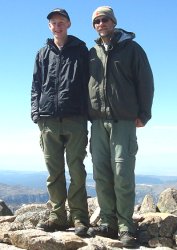Top of the World
 Preparation, perseverence, and perspiration pay off!
Preparation, perseverence, and perspiration pay off!At 13,167 feet, the top of Cloud Peak offers a breathtaking view in all directions of the Big Horn mountains and lands far off in the distance.
The climb up took almost six hours. For the first four and a half hours, the top had clouds rolling across so we did not know if we could make the summit. Finally, the sun won the battle and burned off the moisture, resulting in the most fabulous views I've yet seen from Cloud.
We started our ascent at 5:30am from 10,300 and gained almost 2,900 feet over rocks and boulders. The scramble up wears out your muscles, fighting against gravity and burning your energy reserves. Even though it is tiring, it is not as dangerous as the descent.
After enjoying the view for a half hour, the long climb down began. At first, it's easy with gravity helping you drop down the mountain. But, the pounding weight of your body dropping on each step can soon wear on your joints. The muscles fatigued from climbing up are less stable and steps are longer on the downhill.
Clambering down a rock slope requires care, concentration, and caution. Going uphill, there is very little momentum so a mis-step is more easily recovered. But, a downhill slip can mean a quick fall of a few feet and dire consequences.
Mountain climbers say reaching the summit is optional but getting home is not. That is a key thought I keep in mind all the time on treks. The mountain will be there tomorrow and next year. So, if the weather is bad, the people are worn out, or for some other reason, don't force the ascent - try it another time.
And, when you do reach the top - aaaaah! enjoy the view!
Scout On
Posted: 23:30 08-10-2010 512
Comment or Question about this page:
Scouting 2025 - Ask a Question - Add Content
Just for Fun: Socializing merit badge




This site is not officially associated with Scouting America
Find more Scouting Resources at www.BoyScoutTrail.com



Follow Me, Scouts
Recent Comments